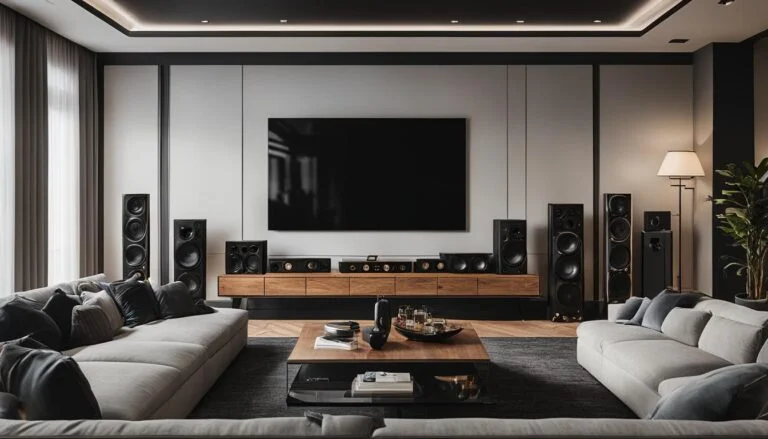The world of home design is undergoing a transformation with the introduction of Augmented Reality (AR) technology. Through the power of AR, homeowners can now seamlessly blend the virtual and physical worlds, bringing their design visions to life like never before. By overlaying digital renderings onto their existing spaces, homeowners can explore different design options, visualize changes, and make informed decisions with confidence.
AR has revolutionized the way we approach home remodeling projects. It allows homeowners to step into a virtual world where they can experience their dream spaces before any physical work takes place. With virtual walkthroughs, homeowners gain a true sense of the end result, enabling them to fine-tune every detail and ensure their vision becomes a reality.
The integration of AR technology into the home design process offers a myriad of benefits. It enhances visualization, making it easier for homeowners to understand and assess design concepts. It streamlines communication between homeowners, contractors, and designers, as everyone can reference the same digital renderings. This ensures that everyone involved is on the same page, minimizing misunderstandings and costly mistakes.
Furthermore, AR in home design reduces uncertainty and increases client satisfaction. Homeowners can see exactly how different design choices will look in their own spaces, eliminating any doubts or concerns. They can confidently make decisions about colors, materials, and layouts, knowing exactly how the end result will look and feel best Augmented Reality in Design.
Through the blending of virtual and physical spaces, AR in home design opens up a world of possibilities. Homeowners can experiment with different styles, rearrange furniture virtually, and even explore unconventional design ideas that may have been difficult to envision in the past.
- Augmented Reality (AR) technology is revolutionizing the home design industry, allowing homeowners to seamlessly blend the virtual and physical worlds.
- AR enables homeowners to overlay digital renderings onto their existing spaces, providing a realistic visualization of design options.
- Virtual walkthroughs using AR technology allow homeowners to experience their redesigned spaces before any physical work takes place, leading to informed decision-making and increased satisfaction.
- AR enhances visualization, streamlines communication, and reduces uncertainty in the home design process.
- By leveraging AR technology, homeowners can explore a multitude of design possibilities and make confident decisions about their dream spaces.
The Benefits of AR and VR in Home Remodeling
The integration of Augmented Reality (AR) and Virtual Reality (VR) technologies has brought significant benefits to the home remodeling industry. These cutting-edge technologies offer homeowners an array of advantages, enhancing their remodeling experience and ensuring satisfaction with the end results.
Enhanced Visualization
AR and VR enable homeowners to clearly visualize design concepts and changes within their existing space. By overlaying digital renderings onto real-world environments, these technologies provide a realistic preview of how the remodeled space will look. This visual representation helps homeowners make informed decisions about design choices and ensures their vision is accurately translated into the final project.
Reduced Uncertainty
AR and VR eliminate uncertainties in the remodeling process by allowing homeowners to experience the redesigned space before any construction begins. Through immersive virtual walkthroughs, homeowners can explore the remodeled environment from various angles and perspectives. This firsthand experience minimizes uncertainty and ensures confidence in the chosen design.
Streamlined Communication
Effective communication is crucial in home remodeling projects. AR and VR facilitate seamless collaboration among homeowners, contractors, and designers by providing shared visual references. This shared understanding ensures everyone involved is on the same page when discussing design decisions and project specifications.
Cost Savings
AR and VR play a significant role in minimizing costly revisions during the remodeling process. By allowing design iterations and changes to be made in the virtual environment, homeowners can explore different options and make adjustments before committing to physical construction. This proactive approach reduces the likelihood of expensive alterations and ensures projects stay within budget.
Increased Client Satisfaction
The combination of enhanced visualization, reduced uncertainty, streamlined communication, and cost savings offered by AR and VR leads to increased client satisfaction. Homeowners can actively participate in the remodeling journey, ensuring their vision is accurately realized. The ability to make informed decisions and see the end result before construction begins fosters a sense of confidence and satisfaction throughout the entire process.
Informed Decision-Making
AR and VR empower homeowners to make well-informed decisions about their remodeling projects. By providing a realistic preview of the remodeled space, homeowners can evaluate different design options and select materials that align with their preferences and needs. This informed decision-making process enhances the overall satisfaction with the final outcome.
The Future of AR and VR in Remodeling
As technology continues to evolve, the future of Augmented Reality (AR) and Virtual Reality (VR) in remodeling looks promising. With advancements in hardware and software, AR and VR are expected to play increasingly vital roles in the remodeling process.
One of the key developments lies in the creation of more realistic simulations. The future will bring simulations that closely mirror physical environments, allowing homeowners to envision their dream spaces with greater clarity. These hyper-realistic virtual simulations will enable a more immersive and engaging experience, helping homeowners make well-informed decisions about their remodeling plans.
Integration of AR and VR into the design and construction workflow will also be seamless. Professionals in the remodeling industry will be able to leverage these technologies to streamline their processes and deliver exceptional results. By utilizing AR and VR tools, designers, architects, and contractors will have the ability to transform abstract concepts into tangible realities, bringing designs to life in virtual environments before any physical work takes place.
The Benefits of AR and VR in the Future of Remodeling
With the future of remodeling being heavily influenced by AR and VR, it’s important to consider the multitude of benefits these technologies will bring to the industry:
- Enhanced Visualization: AR and VR will offer homeowners the ability to visually explore and experience their desired changes in a way that traditional plans or blueprints cannot provide. This enhanced visualization will lead to more accurate decision-making and increased satisfaction with the final product.
- Improved Collaboration: AR and VR will facilitate effective communication among homeowners, contractors, and designers. With shared visual references, all parties involved can easily understand and provide input on design concepts, reducing misunderstandings and delays.
- Cost Savings: By utilizing virtual simulations in the remodeling process, homeowners can experiment with different design options and make changes without the need for costly physical alterations. This will help reduce overall expenses and increase efficiency.
- Virtual Simulations: AR and VR will enable virtual walkthroughs of remodelled spaces, providing homeowners with a realistic sense of the end result before construction begins. This will instill confidence and trust in the remodeling process, ensuring that the final outcome aligns with the homeowner’s vision.
Innovations and Expectations
The future of AR and VR in remodeling holds immense potential. As technology advances, we can expect to see even more innovative applications, enhanced hardware capabilities, and improved software solutions tailored to the needs of the remodeling industry.
In the coming years, we can anticipate the development of advanced hardware devices specifically designed for remodeling purposes. These devices will offer enhanced tracking, improved performance, and increased comfort, providing users with more realistic and immersive experiences.
Furthermore, software advancements will focus on creating intuitive and user-friendly platforms for designing and simulating remodeling projects. The future will offer powerful tools that enable easy collaboration, detailed visualizations, and accurate cost estimations, empowering homeowners and professionals alike.
Ultimately, the future of AR and VR in remodeling is one of endless possibilities. These transformative technologies will shape the way remodeling projects are planned, visualized, and executed, ensuring that homeowners can confidently bring their dream spaces to life.
How CIOs Can Foster Technological Advancements and Innovations
Technological advancements and innovations are essential for organizations to stay competitive and drive sustainable growth in today’s rapidly evolving digital landscape. As key drivers of technology strategy and implementation, Chief Information Officers (CIOs) play a crucial role in fostering these advancements within their organizations. Here are some key steps that CIOs can take to create a culture of innovation and drive technological advancements:
Establish a Vision
It all starts with a clear vision. CIOs should articulate a compelling vision that aligns with the organization’s strategic objectives and sets the direction for technological advancements. This vision should inspire and motivate employees to embrace innovation and push boundaries.
Cultivate a Culture of Innovation
A culture of innovation begins with an environment that encourages creativity, risk-taking, and continuous learning. CIOs should foster a culture where employees feel empowered to share their ideas, experiment with new technologies, and learn from failure. Recognizing and rewarding innovative thinking can further drive a culture of innovation.
Develop an Innovation Framework
An innovation framework provides a structured approach to ideation, prioritization, and implementation of technological advancements. CIOs should establish processes and frameworks that enable the identification and evaluation of new ideas, collaboration across departments, and the seamless integration of emerging technologies into existing systems.
Encourage Collaboration and Cross-Functional Engagement
Collaboration is key to driving technological advancements and fostering innovation. CIOs should encourage cross-functional teams to work together, promoting the exchange of ideas and diverse perspectives. By breaking down silos and facilitating collaboration, CIOs can tap into the collective intelligence of their organization.
Embrace Emerging Technologies
To drive technological advancements, CIOs must embrace emerging technologies and stay abreast of industry trends. By exploring new tools, platforms, and technologies, CIOs can identify opportunities for innovation and proactively leverage them to solve business challenges and drive efficiency.
Promote Continuous Learning
Technological advancements are continuously evolving, and CIOs must prioritize continuous learning and upskilling within their organizations. By investing in training programs, workshops, and knowledge-sharing initiatives, CIOs can ensure that their teams have the skills and knowledge needed to leverage emerging technologies and drive innovation.
Foster External Partnerships
Collaborating with external partners, such as startups, universities, and industry experts, can bring fresh perspectives and cutting-edge technologies to the organization. CIOs should actively seek out partnerships that can drive technological advancements and innovation, leveraging external expertise and resources.
Emphasize Agility and Flexibility
Technological advancements often require agility and flexibility to adapt to changing business needs and market dynamics. CIOs should foster an agile mindset within their organizations, embracing iterative development, rapid prototyping, and flexible project management approaches.
Lead by Example
As leaders, CIOs must lead by example and embody the culture of innovation they seek to foster. By demonstrating a passion for innovation, taking calculated risks, and embracing new technologies, CIOs can inspire and motivate their teams to embrace change and drive technological advancements.
Measure and Communicate Success
Finally, CIOs should establish metrics and key performance indicators (KPIs) to measure the success of technological advancements and innovation initiatives. By tracking and communicating the impact of these advancements on business outcomes, CIOs can create a compelling case for continued investment in technology and innovation.
By following these steps, CIOs can create a culture that embraces continuous technological advancement, fosters innovation, and drives sustainable growth. With CIOs leading the way, organizations can leverage technological advancements to gain a competitive edge in today’s digital world.
The Rise of Augmented Reality in Retail
Augmented reality (AR) is revolutionizing the retail sector by enhancing customer experiences and driving sales. With AR, retailers can overlay computer-generated visuals onto the real world, allowing customers to interact with products in innovative and engaging ways. This technology provides practical and entertaining shopping experiences, reducing uncertainty in online purchases and assisting consumers in making informed decisions.
AR in retail unlocks a world of possibilities, enabling customers to visualize how products would look and function in their own lives. Whether it’s trying on virtual clothing, placing furniture in a room to see how it fits, or exploring the features of a new electronic device, AR allows customers to see products come to life before making a purchase.
Retailers across various industries have enthusiastically embraced AR to create unique and immersive shopping experiences. From fashion and cosmetics to home improvement and automotive, AR is transforming the way customers interact with brands and products. By providing a seamless blend of the physical and virtual worlds, retailers can engage and captivate customers in ways that were previously unimaginable.
Benefits of Augmented Reality in Retail
Augmented reality in retail offers numerous benefits for both customers and businesses:
- Enhanced Product Visualization: AR allows customers to visualize and experience products in their intended context, leading to a more accurate understanding of size, scale, and functionality.
- Increased Consumer Engagement: AR creates interactive and immersive experiences, capturing customers’ attention and keeping them actively engaged with products.
- Reduced Purchase Uncertainty: By visualizing products in their own environment, customers can confidently make purchase decisions, reducing uncertainty and the likelihood of returns.
- Improved Customer Satisfaction: AR enables customers to make more informed choices, leading to higher levels of satisfaction and a positive brand perception.
- Boosted Sales: By providing captivating and personalized experiences, AR has been shown to increase sales conversion rates and average order values.
Case Study: Virtual Try-On in the Beauty Industry
The beauty industry has successfully integrated AR technology to enhance the customer experience. Many beauty brands now offer virtual try-on features that enable customers to experiment with different makeup products without physically applying them.
| Brand | Virtual Try-On Features |
|---|---|
| L’Oréal Paris | Virtual Makeup Try-On |
| Sephora | Virtual Artist |
| MAC Cosmetics | Virtual Try-On |
These virtual try-on features utilize facial tracking technology to accurately overlay makeup products onto customers’ faces in real-time. Customers can see how different shades of foundation, eyeshadow, lipstick, and other products look on them, helping them make confident purchasing decisions.
The seamless integration of AR into the beauty industry has not only transformed the way customers explore and select products but also increased the overall engagement and satisfaction of beauty enthusiasts.
Augmented reality in retail is here to stay, and its impact will only continue to grow. As technology advances and AR becomes more accessible and intuitive, retailers will have even greater opportunities to create immersive and personalized shopping experiences that delight customers and drive business success.
Technology Considerations for AR Room Planning Apps
When building AR room planning apps, it is essential to consider various technologies that play a crucial role in their functionality and user experience. These technology considerations include:
1. Choosing between Marker-Based and Markerless AR
In AR room planning apps, developers can opt for either marker-based or markerless AR technologies. Marker-based AR relies on specific markers or objects in the real-world environment to anchor and augment virtual content. On the other hand, markerless AR functions independently of markers, utilizing advanced computer vision algorithms to detect and understand the surrounding environment. Each approach has its pros and cons, and the choice should be based on the specific requirements of the app and the desired user experience.
2. Leveraging Platform-Dependent Capabilities
AR room planning apps leverage the capabilities of Android and iOS devices to enhance the overall experience. These capabilities include cameras, GPS, accelerometers, gyros, and magnetometers, which provide crucial inputs for accurate spatial tracking, object recognition, and interaction. By utilizing these platform-dependent capabilities effectively, developers can ensure optimal performance and seamless integration of AR features into their room planning apps.
3. Utilizing Augmented Reality Software Development Kits (SDKs) and Specialized Tools
To build robust AR room planning apps, developers can leverage augmented reality software development kits (SDKs) and specialized tools. These SDKs provide pre-built functions and libraries that facilitate the implementation of AR features, such as marker detection, tracking, and object recognition. Popular AR SDKs like Vuforia, ARCore, and ARKit offer different functionalities and compatibility with Android and iOS devices. Additionally, specialized room planning tools like SceneKit, RealityKit, and RoomPlan simplify the creation of detailed and interactive 3D environments in AR room planning apps.
By carefully considering these technology aspects, developers can create AR room planning apps that deliver outstanding user experiences, seamless functionality, and practical utility.
Technologies in Building AR Room Planning Apps
Building AR room planning apps requires a robust technology stack that combines augmented reality software development kits (SDKs) with specialized room planning tools. This combination enables the creation of detailed and interactive 3D environments, empowering users to visualize and explore different design possibilities.
Augmented Reality SDKs for Core AR Capabilities
The foundation of AR room planning apps lies in the choice of an augmented reality software development kit (SDK). These SDKs provide essential AR functionalities, such as object detection, tracking, and rendering, making it possible to overlay virtual elements onto the real world. Popular AR SDKs for building room planning apps include:
- Vuforia: Known for its marker-based tracking technology, Vuforia offers robust image recognition capabilities, enabling precise placement of virtual objects within real-world environments. It supports both Android and iOS devices, providing developers with flexibility.
- ARCore: Developed by Google, ARCore is an AR platform that utilizes motion tracking, environmental understanding, and light estimation to enable realistic AR experiences. ARCore-powered apps are compatible with a wide range of Android devices, making it accessible to a large user base.
- ARKit: Apple’s ARKit is a powerful SDK specifically designed for iOS devices. It leverages advanced computer vision techniques to seamlessly integrate virtual content with the real world, enabling immersive AR experiences on iPhones and iPads.
Room Planning Tools for Creating 3D Environments
In addition to AR SDKs, room planning tools play a crucial role in the development of AR room planning apps. These tools simplify the creation of detailed 3D scenes, physics simulations, and animations, enhancing the overall user experience. Some popular room planning tools include:
- SceneKit: SceneKit is a 3D rendering and animation framework provided by Apple. It offers a wide range of tools and features to create rich and interactive 3D environments for AR applications on iOS devices.
- RealityKit: Developed by Apple, RealityKit is a high-level framework that allows developers to build AR experiences with ease. It provides a suite of tools for realistic rendering, physics-based interactions, and entity-based scene management.
- RoomPlan: RoomPlan is a specialized tool that focuses on room layout and interior design. It offers intuitive drag-and-drop functionality, allowing users to place furniture and decor items within their virtual spaces, providing a realistic preview of the final design.
The integration of AR SDKs and room planning tools empowers developers to create immersive and user-friendly AR room planning apps, revolutionizing the way homeowners envision and plan their spaces.
Technology Stack Overview
| Technology | Description |
|---|---|
| Augmented Reality Software Development Kit (SDK) | A software development kit that provides core AR capabilities, including object detection, tracking, and rendering. |
| Room Planning Tools | Specialized tools for creating detailed and interactive 3D environments, simplifying the creation of 3D scenes, physics simulation, and animation. |
By leveraging the power of augmented reality SDKs and room planning tools, developers can create AR room planning apps that revolutionize the home remodeling industry. These apps provide homeowners with the ability to visualize and explore various design options, ultimately leading to more informed decisions and higher client satisfaction.
Conclusion
Augmented reality (AR) is revolutionizing the home remodeling industry, empowering homeowners to visualize design concepts and make informed decisions before any physical work takes place. With the added benefits of virtual reality (VR), AR offers enhanced visualization, reduced uncertainty, streamlined communication, cost savings, increased client satisfaction, and informed decision-making.
As technology continues to advance, AR and VR are expected to play an even bigger role in the remodeling process, shaping the future of design. Homeowners can now bring their dream spaces to life, exploring different options and experiencing the end result in a virtual environment. The integration of AR and VR in the remodeling industry is transforming abstract concepts into tangible realities, maximizing client satisfaction and improving the overall design process.
Looking ahead, the potential for AR and VR in design is limitless. These technologies have the power to transform how we approach home remodeling, creating unique and immersive experiences for both homeowners and professionals. As AR and VR become increasingly integral to the remodeling process, we can expect a future where visualization, communication, and collaboration are revolutionized, paving the way for innovative and extraordinary design solutions.
Frequently Asked Questions
Decode the magic of gardens with our guide to Landscaping Styles Frequently Asked Questions.
- Augmented reality in home design refers to the use of technology that overlays digital renderings of proposed changes onto existing spaces. This allows homeowners to visualize design options and make informed decisions before any physical work takes place.
- AR enhances home remodeling projects by providing homeowners with a clear visualization of design concepts and allowing them to experience the end result before construction starts. This reduces uncertainty, streamlines communication, and leads to higher client satisfaction.
- The benefits of AR and VR in home remodeling include enhanced visualization, reduced uncertainty, streamlined communication, cost savings, increased client satisfaction, and informed decision-making.
- CIOs can foster technological advancements and innovations by establishing a vision, cultivating a culture of innovation, developing an innovation framework, encouraging collaboration and cross-functional engagement, embracing emerging technologies, promoting continuous learning, fostering external partnerships, emphasizing agility and flexibility, leading by example, and measuring and communicating success.
- Augmented reality is transforming the retail sector by enhancing customer experiences and increasing sales. It allows customers to interact with products in innovative and engaging ways, reducing uncertainty in online purchases and assisting consumers in making informed decisions.
- Important technology considerations for AR room planning apps include choosing between marker-based and markerless AR, leveraging platform-dependent capabilities such as cameras and sensors, and utilizing augmented reality software development kits (SDKs) and specialized tools.
- The technology stack for AR room planning apps includes an augmented reality software development kit (SDK) for core AR capabilities and specialized room planning tools for creating detailed and interactive 3D environments. Popular AR SDKs include Vuforia, ARCore, and ARKit, while room planning tools like SceneKit, RealityKit, and RoomPlan simplify the creation of 3D scenes, physics simulation, and animation.
- As technology continues to advance, augmented reality (AR) is expected to become even more integral to the remodeling process, offering increasingly realistic simulations and seamless integration into the design and construction workflow. AR has the potential to transform abstract concepts into tangible realities, shaping the future of remodeling.
Recent Posts
- Modern Mural Ideas Transforming Walls into Artworks
- Thematic Table Decor Dressing Your Table for Special Occasions
- Festive Lighting Ideas Brightening Your Home for the Holidays
- Biodegradable Decor Materials Choosing Earth-Friendly Options
- Personalized Space Decor Making Your Home Uniquely Yours
- New Year’s Eve Decor Ringing in the New Year in Style
- Transforming Junk into Decor Upcycling at Its Best
- Second-Life Decor Objects Giving Old Items New Purpose
- Unique Decoration Crafting Standout Ideas for Your Home
- Environmentally Friendly Styling Decor with a Conscience












